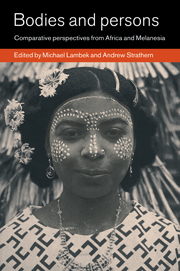Book contents
- Frontmatter
- Contents
- List of illustrations
- List of contributors
- Acknowledgments
- 1 Introduction: Embodying sociality: Africanist–Melanesianist comparisons
- Part I Transcending dichotomies
- 2 “It's a boy,” “it's a girl!” Reflections on sex and gender in Madagascar and beyond
- 3 Modernity and forms of personhood in Melanesia
- 4 Refiguring the person: the dynamics of affects and symbols in an African spirit possession cult
- 5 Body and mind in mind, body and mind in body: some anthropological interventions in a long conversation
- Part II Transitions, containments, decontainments
- Part III From exchange to history
- Bibliography
- Index
4 - Refiguring the person: the dynamics of affects and symbols in an African spirit possession cult
Published online by Cambridge University Press: 05 June 2012
- Frontmatter
- Contents
- List of illustrations
- List of contributors
- Acknowledgments
- 1 Introduction: Embodying sociality: Africanist–Melanesianist comparisons
- Part I Transcending dichotomies
- 2 “It's a boy,” “it's a girl!” Reflections on sex and gender in Madagascar and beyond
- 3 Modernity and forms of personhood in Melanesia
- 4 Refiguring the person: the dynamics of affects and symbols in an African spirit possession cult
- 5 Body and mind in mind, body and mind in body: some anthropological interventions in a long conversation
- Part II Transitions, containments, decontainments
- Part III From exchange to history
- Bibliography
- Index
Summary
Persons and selves: the politics of representation
Throughout history, the description of other cultures has been shaped by a politics of representation which can be neither dissociated from nor subjected to the relationships of power and domination constitutive of the colonial order. Travel narratives and ethnographic descriptions of explorers, missionaries, and merchants are permeated by the unusual super-position between a referential use of language, supposed to provide a precise description of an objective reality “out there” to be described, classified, categorized through language, and the oniric representation of the world in which the Other becomes an imaginary screen for projecting the hidden fantasies, desires, anxieties, and the dark side of our own being (Obeyesekere 1995; Taussig 1987; Zavala 1989). Post-colonial criticism has dealt with both of these aspects, but behind the power politics of the colonial encounter, we can see that this problematic representation of other cultures reveals the difficulties and limitations of the encounter with the Other and the danger of drifting toward objectiflcation and subjectification when minimizing or absorbing the alterity of the Other within the illusory continuum of an immediate understanding. Solutions proposed by contemporary anthropology to the aporia of the encounter with the other are often unsatisfactory since they themselves are embedded within a North American ethos organized around notions of “empathy,” “feeling,” and “experience”.
The first travel narratives described other customs, ways of being, and beliefs from a natural history perspective with the intention of creating a taxonomy of non-human and human objects and species.
- Type
- Chapter
- Information
- Bodies and PersonsComparative Perspectives from Africa and Melanesia, pp. 80 - 102Publisher: Cambridge University PressPrint publication year: 1998
- 33
- Cited by

